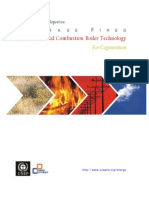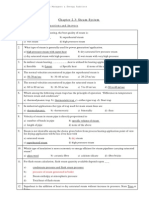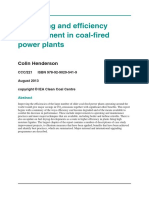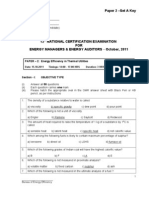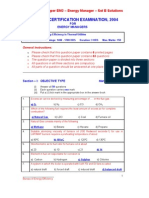National Certification Examination, 2004: Paper EM2 - Energy Manager - Set B Solutions
National Certification Examination, 2004: Paper EM2 - Energy Manager - Set B Solutions
Uploaded by
raghavan1984Copyright:
Available Formats
National Certification Examination, 2004: Paper EM2 - Energy Manager - Set B Solutions
National Certification Examination, 2004: Paper EM2 - Energy Manager - Set B Solutions
Uploaded by
raghavan1984Original Title
Copyright
Available Formats
Share this document
Did you find this document useful?
Is this content inappropriate?
Copyright:
Available Formats
National Certification Examination, 2004: Paper EM2 - Energy Manager - Set B Solutions
National Certification Examination, 2004: Paper EM2 - Energy Manager - Set B Solutions
Uploaded by
raghavan1984Copyright:
Available Formats
Paper EM2 Energy Manager Set B Solutions
NATIONAL CERTIFICATION EXAMINATION, 2004
FOR ENERGY MANAGERS
PAPER EM2: Date: 22.05.2004 Energy Efficiency in Thermal Utilities Timings: 1400 - 1700 HRS Duration: 3 HRS Max. Marks: 150
General instructions: o o o o o Please check that this question paper contains 6 printed pages Please check that this question paper contains 65 questions The question paper is divided into three sections All questions in all three sections are compulsory All parts of a question should be answered at one place
Section I: OBJECTIVE TYPE
(i) (ii) (iii) 1.
Marks: 50 x 1 = 50
Answer all 50 questions Each question carries one mark Put a () tick mark in the appropriate box in the answer book
Excess air can be derived by measuring percentage of . in the flue gas a) O2 b) N2 c) CO d) CH4
2.
Which of the following fuel requires the least amount of excess air for complete combustion? a) Natural Gas b) LDO c) Coal d) Furnace oil
3.
Natural Gas consists mainly of the following a) Methane b) Butane c) Hexane d) Propane
4.
Suitable atomizing viscosity of furnace oil (100 Redwood seconds-1) for use in LAP/MAP burners requires a preheating temperature of about a) 90oC b) 105oC c) 120oC d) 130oC
5.
Stoichiometric air to fuel ratio for furnace oil is about a) 20 b) 10 c) 21 d) 14
6.
Element in fuel oil responsible for corrosion is a) Carbon b) Hydrogen c) Sulphur d) Chlorine
7.
A system in which the boiler is operated with both FD and ID fans is called a) natural draft b) forced draft c) induced draft d) balanced draft 1
_______________________ Bureau of Energy Efficiency
Paper EM2 Energy Manager Set B Solutions
8. Steam generation in a boiler is 72 tonnes in 3 hours. The fuel consumption in the same period is 2 tonnes per hour. The evaporation ratio is a) 12 9. b) 36 c) 24 d) 18
Boiler economizer is used to extract heat from flue gases for preheating a) fuel oil b) air for combustion of fuel c) feed water d) blow down
10.
The limiting temperature to which the flue gases can be cooled is influenced by percentage of a) volatile matter of fuel c) sulphur in fuel b) hydrogen in fuel d) ash in fuel
11
An IBR steam boiler means any closed vessel exceeding litres in capacity and which is expressively used for generating steam under pressure. a) 18.75 b) 20.75 c) 22.75 d) 24.75
12.
Turn down ratio of a burner is the ratio of a) maximum and minimum fuel input without affecting optimum excess air levels b) minimum and maximum fuel input c) maximum and average fuel input d) average and minimum fuel input
13.
The heat necessary to change liquid water at boiling temperature to saturated steam is called a) sensible heat b) specific heat c) latent heat b) superheat
14.
Which steam trap is temperature actuated? a) mechanical trap c) orifice type b) thermostatic trap d) none of the above
15.
Heat loss through openings in furnaces is directly proportional to a) fourth power of furnace temperature b) square of absolute furnace temperature c) fourth power of absolute furnace temperature d) absolute furnace temperature
16.
Outer surface losses of a furnace do not depend on which of the following a) temperature of external wall surfaces c) temperature around the furnace b) furnace draft d) emissivity of external wall surfaces
17.
Maximum heat transfer to the stock in a reheating furnace is by a) radiation b) conduction c) convection d) none of the above
18.
Which of the following influences energy savings by ceramic coatings in furnaces a) conductivity c) emissivity b) convective heat transfer coefficient
d) none of the above
_______________________ Bureau of Energy Efficiency
Paper EM2 Energy Manager Set B Solutions
19. Which of the following is the most important property of an insulating brick with respect to energy savings? a) porosity c) colour 20. b) mechanical strength d) compactness
Low combustion temperature in FBC boiler results in reduced formation of a) SOx b) NOx c) CO2 d) CO
21.
The function of lime stone used as bed material in FBC boilers is to remove a) ash b) carbon c) sulphur d) unburnt
22.
A major advantage of PFBC boilers over conventional pulverised coal fired boilers is a) low excess air c) low radiation loss b) compactness in size d) less ash removal
23.
A cycle which generates electricity or mechanical power first is called a) bottoming cycle b) topping cycle c) combined cycle d) cogeneration
24.
Which of the following industries may not be ideal for cogeneration a) Foundry b) Paper c) Refinery d) Fertilizer
25.
What average rise in temperature of combustion air results in about 1 per cent increase in the efficiency of an oil fired boiler. a) 10oC b) 20oC c) 30oC d) 40oC
26.
The ideal heat recovery device for very high temperature gases is a) plate heat exchanger c) regenerator b) heat pipe d) thermocompressor
27.
Water hammer in a steam pipe line system is caused by a) long steam pipe c) sudden closure of governor valve b) collection of condensate in pipe work d) sudden variation of steam pressure
28.
Heat required to change the liquid phase of water at boiling point to saturated steam at the same pressure is called a) sensible heat b) super heat c) latent heat d) specific heat
29.
As the pressure of water increases from 1kg/cm2 to 8 kg/cm2, the values of enthalpy of steam and enthalpy of evaporation respectively a) increases & remains the same c) decreases & increases b) increases & decreases d) decreases & remains the same
30.
The axis of the burner in a furnace should be kept a) slightly inclined towards the roof c) parallel to stock b) slightly inclined towards the stock
d) none of the above
_______________________ Bureau of Energy Efficiency
Paper EM2 Energy Manager Set B Solutions
31. Instrument used for measuring billet surface temperature in a reheating furnace is a) infrared pyrometer c) thermograph 32. b) Pt/Pt-Rh thermocouple with indicator d) chrome alumnel thermocouple with indicator
Supply of large amounts of excess air to a furnace burner above its optimum value a) increases both furnace temperature and flue gas losses b) decreases furnace temperature and increases flue gas losses c) increases furnace temperature and decreases flue gas losses d) decreases both furnace temperature and flue gas losses
33.
The best insulation for a batch type furnace is a) ceramic coating b) ceramic fibre c) rock wool d) glass wool
34.
The most common refractory used in furnaces is a) zirconia brick b) magnesite brick c) fire brick d) silica brick
35.
As the furnace temperature increases, the emissivity of most refractory materials a) increases upto a certain level and then decreases b) increases c) decreases d) decreases upto a certain level and then increases
36.
While retrofitting of FBC systems to conventional boilers, the important aspect to be considered is a) water/steam circulation design c) type of particulate control device b) furnace bottom-grate clearance d) all the above
37.
Which of the following affect the combustion performance? a) temperature b) time c) turbulence d) all the above
38.
The efficiency of which of the following turbine systems is the highest a) condensing c) double extraction condensing b) back pressure d) extraction condensing
39
A waste heat recovery steam generator is used with a) steam turbines c) gas turbines b) back pressure turbines d) condensing turbines
40.
The Brayton cycle is a characteristic of a) Steam turbine b) Otto Engine c) Gas turbine d) none of the above
41.
The air compressor of a gas turbine alone consumes about of the power out put generated by gas turbine a) 30% - 40% b) 50% - 60% c) 20% - 30% d) 40% - 50%
42.
Combined cycle is a combination of a) conventional boiler first followed by cogeneration system b) Brayton cycle first followed by a standard Rankine cycle c) Rankine cycle first followed by a Brayton cycle d) extraction in the first portion and then a condensing cycle
_______________________ Bureau of Energy Efficiency
Paper EM2 Energy Manager Set B Solutions
43. Recuperator is a waste heat recovery system mainly found with a) blast furnace c) billet reheating furnace 44. b) compressor d) none of the above
Which of the following is not a waste heat recovery device a) heat pump b) thermocompressor c) heat wheel d) diesel engine
45.
The major limitation of metallic recuperator is a) limitation of handling SOx, NOx gases b) limitation of reduced life for handling temperature more than 10000C c) manufacturing difficulty of the required design d) none of the above
46.
Ceramic recuperators can withstand temperatures up to a) 17000C b) 6000C c) 13000C d) 9500C
47.
Regenerator is widely used in a) reheating furnaces c) heat treatment furnaces b) baking ovens d) glass melting furnaces
48.
For every 6oC rise in feed water temperature through an economizer the fuel savings in an oil fired boiler is of the order of a) 1.5% b) 1% c) 2% d) 3%
49.
In a low to medium temperature waste heat recovery system which of the device is finding increasing applications. a) heat wheel b) recuperator c) economizer d) air preheater
50.
The insulation refractory which can be used for lining furnaces operating up to temperature of 1800oC is a) zirconia b) calcium silicate c) alumina d) dolomite
Solution Key for Objective
Question 1 2 3 4 5 6 7 8 9 10 11 12 13 Manager B a a a b d c d a c c c a c 5
_______________________ Bureau of Energy Efficiency
Paper EM2 Energy Manager Set B Solutions
14 15 16 17 18 19 20 21 22 23 24 25 26 27 28 29 30 31 32 33 34 35 36 37 38 39 40 41 42 43 44 45 46 47 48 49 50 b c b a c a b c b b a b c b c b c a b b c c d d b c c b b c d b c d b a c
. End of Section I . Section II: SHORT DESCRIPTIVE QUESTIONS
(i) (ii) S-1. Answer all Ten questions Each question carries Five marks Marks: 10 x 5 = 50
Explain the importance of furnace draft. What pressure should be maintained in a furnace for efficient operation?
_______________________ Bureau of Energy Efficiency
Paper EM2 Energy Manager Set B Solutions
Neglecting furnaces pressure could mean problems of cold metal and nonuniform metal temperatures, which could affect subsequent operations like forging and rolling and result in increased fuel consumption. For optimum fuel consumption, slight positive pressure should be maintained in the furnace because this will prevent cold air infiltration into the furnace. S-2. The evaporation ratio of a coal fired boiler is 4. Estimate boiler efficiency if steam enthalpy is 640 kcal/kg; feed water temperature is 55 0C and Calorific Value of coal is 4000 kcal/kg. = = = output/input * 100 100 x Q (H-h) / (q x GCV) 4x (640-55) x 100 ----------------------- = 58.5 %. 1 x 4000
Boiler efficiency Boiler efficiency
S-3.
Explain how cogeneration is advantageous over separate production of electricity and heat.
Conventional power plant efficiency is about 35% and remaining 65% energy is lost. Cogeneration is the simultaneous generation of heat and power, both of which are utilized. In cogeneration system, efficiency can go up to 90%. Apart from maximizing efficiency of energy use in cogeneration, there would be price advantages by way of procuring locally available fuel. S-4. Explain the constructional and usage differences between fire tube and water tube boiler.
Fire tube boilers contain steel tubes through which the hot gasses from a furnace pass and around which the water to be converted to steam circulates. Water tube boilers in which the conditions are reversed with the water passing through the tubes and the hot gasses passing outside the tubes. Fire tube boilers are used for low and medium pressure requirement and sluggish, while water tube boilers are used for medium and high pressure steam requirements. S-5. Briefly explain the principle of a thermocompressor.
It is possible to compress low pressure steam by very high pressure steam and reuse it as a medium pressure steam. The major energy in steam is in its latent heat value and thus thermo compressing would give a large improvement in waste heat recovery. The thermo compressor is simple equipment with a nozzle where HP steam is injected in a convergent divergent nozzle, this creates a large velocity. The
_______________________ Bureau of Energy Efficiency 7
Paper EM2 Energy Manager Set B Solutions
low pressure steam is entrained by momentum transfer and then recompressed in the divergent venture section to an intermittent pressure. S-6. What is the economic thickness of insulation?
The economic thickness of insulation is the thickness at which, if we make the insulation even thicker, the additional costs would not be recovered by the additional savings through reduction of heat losses. S-7. Explain the difference and common properties between saturated steam and saturated water at the same pressure.
The differences are (i) (ii) Steam is a gas while water is a liquid Steam has a higher enthalphy because heat of evaporation is added.
The common properties are (i) S-8. The temperature is the same. Given the choice would you paint the outer surface of a reheating furnace black, or with a shiny glossy colour (such as silver colour). Explain!
The emissivity of the outer surface should be kept to a minimum since the skin losses would increase with high emissivity. A black colour acts like a black body with highest emissivity, while a glossy and shiny aluminium foil has about the lowest emissivity. Therefore, radiation loss is minimized. Shiny glossy colour, which has a lower emissivity should be used. S-9. What is meant by excess air? Why it should be optimized?
A fuel specific amount of air called theoretical or stoichiometric air is required for perfect combustion. In practice some additional air is required for ensuring complete combustion, which is known as excess air. Excess air should be optimised because any additional air will increase the amount of stack gas and with it increases the stack gas losses. S-10. What is the function of air distribution in FBC boiler? The purpose of the air distributor is to introduce the fluidizing air evenly through the bed cross section thereby keeping the solid particles in constant motion, and preventing the formation of de-fluidization zones within the bed.
. End of Section II ..
_______________________ Bureau of Energy Efficiency
Paper EM2 Energy Manager Set B Solutions
Section III: LONG DESCRIPTIVE QUESTIONS
(i) (ii) L-1. Answer all Five questions Each question carries Ten marks Marks: 5 x 10 = 50
Condensate return at a pressure of 20 atm (enthalpy of saturated water at 20 atm = 235 kcal/kg) is released at atmospheric pressure (enthalpy of saturated water at 1 atm = 100 kcal/kg). Calculate the percentage of flash steam and the heat carried away by the flash. The latent heat of evaporation of water at 1 atm is equal to 540 kcal/kg. S1S2 L2
Flash steam available % =
Where: S1 is the sensible heat of higher pressure condensate. S2 is the sensible heat of the condensate at lower pressure (at which it has been flashed). L2 is the latent heat of flash steam (at lower pressure). % of flash steam generated = 235 100 *100 = 25% 540 0.25 * 640 * 100 = 68% 235
% of heat carried by flash steam = L-2.
Explain four types of topping cycle cogeneration systems?
The four types of topping cycle cogeneration systems are: (1) Combined-cycle topping system: A gas turbine or diesel engine producing electrical or mechanical power followed by a heat recovery boiler to create steam to drive a secondary steam turbine. (2) Steam-turbine topping system: The second type of system burns fuel (any type) to produce high-pressure steam that then passes through a steam turbine to produce power with the exhaust provides low-pressure process steam. (3) Diesel Generator topping system: Hot water from an engine jacket cooling system flowing to a heat recovery boiler, where it is converted to process steam and hot water for space heating. (4) Gas-turbine topping system: A natural gas turbine drives a generator. The exhaust gas goes to a heat recovery boiler that makes process steam and process heat.
L-3.
What are waste heat recovery boilers? Explain the need and benefits?
9
_______________________ Bureau of Energy Efficiency
Paper EM2 Energy Manager Set B Solutions
Waste heat recovery boilers are ordininarily water tube boilers in which the hot exhaust gases from a gas turbine, reciprocating engines, furnaces, incinerator are used to generage steam. The need and benefits are: (i) (j) It meets or augments the process steam demand . separate fuel fired steam boiler may be avoided or reduces the fuel requirement. Reducing stack gas temperature by an order of 20 deg C i.e. waste heat recovery will save also 1% fuel Why is it advantageous to use steam at the lowest acceptable pressure in a process.
(k)
L-4.
The latent heat in steam reduces as the steam pressure increases. It is only the latent heat of steam, which takes part in the heating process when applied to an indirect heating system. Thus, it is important that its value be kept as high as possible. This can only be achieved if we go in for lower steam pressures. The lower the steam pressure, the lower will be its temperature. Since temperature is the driving force for the transfer of heat at lower steam pressures, the rate of heat transfer will be slower and the processing time greater. Therefore, there is a limit to the reduction of steam pressure. Depending on the equipment design, the lowest possible steam pressure with which the equipment can work should be selected without sacrificing either on production time or on steam consumption. L-5. Explain the difference between batch type and continuous furnace. Where and how does additional heat loss take place in a batch type furnace compared to continuous furnace? The differences between batch furnace and continuous furnace are:
i)
a) Batch type The charging and discharging of the material is done manually. There is fixed time cycle for the stock to be heated and processed and all the stock material are ready for further processing at one time. Efficiency of batch type furnaces are low as compared to continuous type. b) Continuous Type: The charging and discharging of the material is done mechanically and the stock is available on a one in one out basis resulting in better productivity of the down stream equipments. The material or stock recovers a part of the heat in flue gases as it moves down the length of the furnace.
_______________________ Bureau of Energy Efficiency 10
Paper EM2 Energy Manager Set B Solutions
Heat absorption by the material in the furnace is slow, steady and uniform throughout the cross-section compared with batch type. ii) The additional heat loss take place in a batch type furnace compared to continuous furnace in the following areas:
The batch type furnaces cools down between batches and the refractories need to be heated to the process temperature consuming additional heat. More over the stack gases leaves the furnace at higher temperature in a batch furnace as compared to continuous furnace wherein the stack gases pass through the stock and preheats them to considerable temperature before they leave the furnace.
. End of Section III .
_______________________ Bureau of Energy Efficiency
11
You might also like
- Bureau of Energy EfficiencyDocument2 pagesBureau of Energy EfficiencyrkNo ratings yet
- Regular Paper 2 - Set A: Section - Ii: Short Descriptive QuestionsDocument23 pagesRegular Paper 2 - Set A: Section - Ii: Short Descriptive QuestionsYogaAnandNo ratings yet
- Paper 2 - Set B Solutions: General InstructionsDocument12 pagesPaper 2 - Set B Solutions: General InstructionsRichard RegidorNo ratings yet
- 2 BDocument13 pages2 BSonali PriyadarshiniNo ratings yet
- Paper 2 Set B 24nov2009 KeyDocument14 pagesPaper 2 Set B 24nov2009 KeySHAMSIK2002No ratings yet
- Model Question Paper - 2006Document13 pagesModel Question Paper - 2006Faiq HasnainNo ratings yet
- 142 BDocument15 pages142 BarunachalamNo ratings yet
- Ea2a PDFDocument7 pagesEa2a PDFMayukh DebdasNo ratings yet
- Paper 2 - Set B Solution: General InstructionsDocument16 pagesPaper 2 - Set B Solution: General InstructionsMukesh KumarNo ratings yet
- 2a KeyDocument16 pages2a KeyHimanshu RanjanNo ratings yet
- Paper 2 - Set A Solution: General InstructionsDocument16 pagesPaper 2 - Set A Solution: General InstructionsMukesh KumarNo ratings yet
- Paper 4 - Energy Auditor - Set B Key: General InstructionsDocument12 pagesPaper 4 - Energy Auditor - Set B Key: General InstructionsRichard RegidorNo ratings yet
- EAs 1 ADocument12 pagesEAs 1 ARajesh Kumar MamidiNo ratings yet
- 2.1 Fuels & Combustion - Revised (Table Format)Document9 pages2.1 Fuels & Combustion - Revised (Table Format)Gajanan JagtapNo ratings yet
- Energy Conservation - 03Document4 pagesEnergy Conservation - 03ashish patelNo ratings yet
- Supplimentary Paper 1 - Set ADocument13 pagesSupplimentary Paper 1 - Set AcynaiduNo ratings yet
- FBC Boiler Technology For OnDocument68 pagesFBC Boiler Technology For Onarjmandquest100% (1)
- National Certification Examination 2005: General InstructionsDocument12 pagesNational Certification Examination 2005: General InstructionsRupesh ParadeNo ratings yet
- BeeDocument20 pagesBeeAnudeep ChittluriNo ratings yet
- EA3ADocument7 pagesEA3AMayukh DebdasNo ratings yet
- 3ADocument16 pages3ASreenivasNo ratings yet
- Paper 3 - Set A KeyDocument18 pagesPaper 3 - Set A KeysamirNo ratings yet
- 13thexampaper4setb PDFDocument12 pages13thexampaper4setb PDFSolaiNo ratings yet
- SUP1SetB PDFDocument13 pagesSUP1SetB PDFcynaiduNo ratings yet
- A Seminar Report On: "Thermal Power Plant "Document61 pagesA Seminar Report On: "Thermal Power Plant "RAMAN100% (1)
- Model SolutionDocument14 pagesModel SolutionSarah FrazierNo ratings yet
- Thermal Lab PPT - Heat Balance SheetDocument10 pagesThermal Lab PPT - Heat Balance SheetAyush SinghalNo ratings yet
- Em3a PDFDocument7 pagesEm3a PDFMayukh DebdasNo ratings yet
- Chapter 2.3: Steam System: Part-I: Objective Type Questions and AnswersDocument7 pagesChapter 2.3: Steam System: Part-I: Objective Type Questions and Answersmaran2786No ratings yet
- Question Bank For Energy Managers & Energy AuditorsDocument56 pagesQuestion Bank For Energy Managers & Energy AuditorsAamir AnsariNo ratings yet
- 4.1 BoilerDocument10 pages4.1 BoilerSURESHHALDIPURNo ratings yet
- Paper 1 - Set B Solutions: General InstructionsDocument16 pagesPaper 1 - Set B Solutions: General Instructionsadir royNo ratings yet
- 13thexampaper1seta (20 Files Merged)Document202 pages13thexampaper1seta (20 Files Merged)ADITYA KUMARNo ratings yet
- Tutorial Spur GearDocument2 pagesTutorial Spur GearMayankVijayNo ratings yet
- Assignment 2Document2 pagesAssignment 2Aman ChaudharyNo ratings yet
- Power Plant and Calculations - Best Practices To Reduce The Auxiliary Power Consumption (APC) in Sugar Based Cogeneration PlantsDocument7 pagesPower Plant and Calculations - Best Practices To Reduce The Auxiliary Power Consumption (APC) in Sugar Based Cogeneration PlantsRajeshNo ratings yet
- 20th Exam P1 B PDFDocument11 pages20th Exam P1 B PDFAlbert SekarNo ratings yet
- POWER PLANT Engineering MCQSDocument16 pagesPOWER PLANT Engineering MCQSParesh100% (1)
- Ccc221coalpowerR MDocument58 pagesCcc221coalpowerR Mmfhaleem@pgesco.comNo ratings yet
- Final Paper 1 Reg Set A20.04.2017 PDFDocument15 pagesFinal Paper 1 Reg Set A20.04.2017 PDFAnudeep ChittluriNo ratings yet
- NTPC (National Thermal Power Corporation) Sipat Mechanical Vocational Training Report 4-Haxxo24 I IDocument44 pagesNTPC (National Thermal Power Corporation) Sipat Mechanical Vocational Training Report 4-Haxxo24 I Ihaxxo24No ratings yet
- 14TH Exam-Paper - 1 - Set - A PDFDocument17 pages14TH Exam-Paper - 1 - Set - A PDFrana_eieNo ratings yet
- Project Report On Thermal PlantDocument58 pagesProject Report On Thermal Plantmenyu198964% (11)
- FBC Boilers - Question Answer 1Document8 pagesFBC Boilers - Question Answer 1Balaji Pillai100% (2)
- Chapter 5 - Combustion EquipmentDocument50 pagesChapter 5 - Combustion EquipmentrrhoshackNo ratings yet
- Power Management InstituteDocument2 pagesPower Management InstituteAhamed JalaludeenNo ratings yet
- 6 Design and Fabrication of Paddy TransplanterDocument14 pages6 Design and Fabrication of Paddy TransplanterMuthuraju NPNo ratings yet
- Model Question Bank Energy Certification For Managers and AuditorsDocument312 pagesModel Question Bank Energy Certification For Managers and AuditorsVanyaChauhan100% (3)
- Energy Adulator Exam PaperDocument17 pagesEnergy Adulator Exam PaperravandkumarNo ratings yet
- Request Letter: Sub:Requesting Experience Certificate For Applying BOE ExamDocument3 pagesRequest Letter: Sub:Requesting Experience Certificate For Applying BOE ExammaheshNo ratings yet
- Cogeneration: The Benefits of CogenerationDocument23 pagesCogeneration: The Benefits of CogenerationJAY PARIKH100% (1)
- Unit 1: Introduction To PPE: A) Power GenerationDocument55 pagesUnit 1: Introduction To PPE: A) Power GenerationArun PatilNo ratings yet
- 2004 Paper 2 Set BDocument6 pages2004 Paper 2 Set BNataraj Singh SardarNo ratings yet
- Paper-2 Set-A KeyDocument14 pagesPaper-2 Set-A Keydkhatri01No ratings yet
- Paper 2 - Set A Solutions: General InstructionsDocument18 pagesPaper 2 - Set A Solutions: General Instructionsjp nayakNo ratings yet
- Paper 2 Set-A - KeyDocument22 pagesPaper 2 Set-A - KeyRichard RegidorNo ratings yet
- Paper - 2 - SetA - 090410 - Key PDFDocument12 pagesPaper - 2 - SetA - 090410 - Key PDFNataraj Singh SardarNo ratings yet
- Paper 2 merged (1)Document221 pagesPaper 2 merged (1)nikitaambeNo ratings yet
- Paper 2 SetB 090410 KeyDocument12 pagesPaper 2 SetB 090410 KeyNataraj Singh SardarNo ratings yet
- Pondicherry SchoolDocument16 pagesPondicherry Schoolraghavan1984No ratings yet
- Curve FittingDocument5 pagesCurve Fittingraghavan1984No ratings yet
- CARD 2014 Summer-TempDocument2 pagesCARD 2014 Summer-Tempraghavan1984No ratings yet
- NLC Personnel Manual Vol-IIDocument210 pagesNLC Personnel Manual Vol-IIraghavan1984100% (2)
- Leadership - Hear The ThinkersDocument11 pagesLeadership - Hear The Thinkersraghavan1984No ratings yet
- Installation 2013Document1 pageInstallation 2013raghavan1984No ratings yet
- PINCH ANALYSIS Part 1 - Pinch and Minimum Utility UsageDocument29 pagesPINCH ANALYSIS Part 1 - Pinch and Minimum Utility Usageraghavan1984No ratings yet
- Attendance Cgb9Document1 pageAttendance Cgb9raghavan1984No ratings yet
- CGB 5 Invitation-13Document1 pageCGB 5 Invitation-13raghavan1984No ratings yet
- National Certification Examination, 2004: Paper EM2 - Energy Manager - Set B SolutionsDocument11 pagesNational Certification Examination, 2004: Paper EM2 - Energy Manager - Set B Solutionsraghavan1984No ratings yet
















